Graphically representing the number of matches played by each club helps illustrate the highs and lows of their footballing journeys over the 52 years of the Maher Cup history, and provides the basis of a brief club history. Failure to capture the Cup meant twiddling thumbs and fretting on the outcome of the next draw.
Cootamundra (224 matches). Playing 62 games more than any other team, Coota started with a bang in 1922 winning in its first game under Phil Regan – the first paid-player coach in the bush. They didn’t let up. Regan’s 1920s blue and whites, featuring players such as Eric Weissel, Jack Kingston, Bill Lesberg and Gordon Hinton utterly dominated their opponents. With a little help they even took on England. During the Depression years, after Regan departed, it all fell apart for a while. 1935 saw the purchase of five paid players, an embarrassing loss to Tumut, and the imports instantly sacked. Coota rose to the top again in 1939 with a team composed mainly of local ex-De La Salle boys. After the war Herb Narvo (1947) and Johnny Graves (1954) led teams of extraordinary quality. Reverting to mainly local players the town continued to be consistently competitive into the 1960s.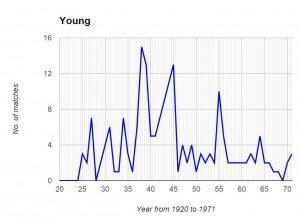
Young (162 matches). While the Young citizenry went crazy like perhaps no other when they first brought the Cup home in 1927, it was the pre-War Bill Kearney years that are remembered as the first golden era. The players were mostly locals with Bill Kinnane, Sid and Abe Hall consistently outstanding. Young re-formed as strong as ever as the War was finishing in 1945, winning twelve straight but couldn’t hold off rampaging Cowra which could draw from its two army camps. Probably no team punted so strongly for high profile paid imports than the money men at Young from 1953 to 1955. The fans loved the quality – with the all-time record Maher Cup crowd squeezing into Alfred Oval on 16 May 1953 to welcome Gundagai. Only one local (John Fisher) played regularly in the side when Leo Trevena’s thirteeen obliterated Maher Cup competitors in 1955 and 56. With opportunities for local League lads limited the Rugby Union club was re-established after a hiatus of 35 years in 1955. When the transfer system forced fiscal frugality in the 1960s Young still remained a tough team to beat.
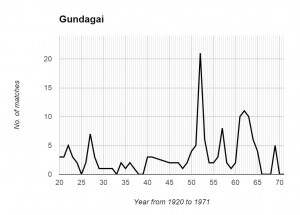 Gundagai (155 matches). ‘Chook’ Fraser’s Gundagai team of 1927 famously forced Cootamundra from the top spot. However it wasn’t until Gundagai’s 21 Maher Cup matches in the year of 1952 that the Tigers were to be again adored far and wide. This was an amazing achievement for the team led by Nevyl Hand. They also backed up every Sunday for the Group 9 competition, and went on to win the Clayton Cup for being the best team in country NSW. From a place with a steady population of just 2,000, this was arguably the most consistently entertaining side ever seen in Maher Cup football. Gundagai was unmatched in its Rugby League passion. Brilliant sports writers, Jim and Pat Sullivan in the Gundagai Independent were read throughout Group 9. The brothers stoked the fire of football fever, picking fights whenever they were needed. Ironically the Sullivans railed in vain against the folly of the Maher Cup for thirty years, considering its ‘lust for lucre‘ detrimental to the development of local football. However after the War the club wholeheartedly joined the lucre lovers. The Tigers roared again in the Maher Cup under Peter Diversi in 1956-1957 and ‘Bronc’ Jones in the early 196os.
Gundagai (155 matches). ‘Chook’ Fraser’s Gundagai team of 1927 famously forced Cootamundra from the top spot. However it wasn’t until Gundagai’s 21 Maher Cup matches in the year of 1952 that the Tigers were to be again adored far and wide. This was an amazing achievement for the team led by Nevyl Hand. They also backed up every Sunday for the Group 9 competition, and went on to win the Clayton Cup for being the best team in country NSW. From a place with a steady population of just 2,000, this was arguably the most consistently entertaining side ever seen in Maher Cup football. Gundagai was unmatched in its Rugby League passion. Brilliant sports writers, Jim and Pat Sullivan in the Gundagai Independent were read throughout Group 9. The brothers stoked the fire of football fever, picking fights whenever they were needed. Ironically the Sullivans railed in vain against the folly of the Maher Cup for thirty years, considering its ‘lust for lucre‘ detrimental to the development of local football. However after the War the club wholeheartedly joined the lucre lovers. The Tigers roared again in the Maher Cup under Peter Diversi in 1956-1957 and ‘Bronc’ Jones in the early 196os.
 The grounds were usually hard and dry out at West Wyalong (152 matches) in the flat mallee scrub. They were also a tough lot, who didn’t import in a big way. In their isolation Wyalong were careful to nurture young talent, particularly in the Half Moons teams. They were always thereabouts in any Maher Cup match. In the twenties with Bill Brogan and Dick Vest they had a team that could defeat Phil Regan’s champion Coota side. Locals like Len Cooper, Bert Williams, the Templemans from Bellarwi, and the Navin and Farrar brothers kept the club most competitive during and after the Depression. In the fifties the Mallee Men emerged stronger than ever, with Ron and Les Crowe, Col Ratcliff, some excellent Broads as always, plus three classy acquisitions from Coota – Fazio, Wheatley and Metcalfe. When the Murrumbidgee Rugby League breakaway took the southern teams out in 1966 – Wyalong were clearly the best side left in Group 9.
The grounds were usually hard and dry out at West Wyalong (152 matches) in the flat mallee scrub. They were also a tough lot, who didn’t import in a big way. In their isolation Wyalong were careful to nurture young talent, particularly in the Half Moons teams. They were always thereabouts in any Maher Cup match. In the twenties with Bill Brogan and Dick Vest they had a team that could defeat Phil Regan’s champion Coota side. Locals like Len Cooper, Bert Williams, the Templemans from Bellarwi, and the Navin and Farrar brothers kept the club most competitive during and after the Depression. In the fifties the Mallee Men emerged stronger than ever, with Ron and Les Crowe, Col Ratcliff, some excellent Broads as always, plus three classy acquisitions from Coota – Fazio, Wheatley and Metcalfe. When the Murrumbidgee Rugby League breakaway took the southern teams out in 1966 – Wyalong were clearly the best side left in Group 9.
 Temora (148 matches) tended to be in great form pretty much when Wyalong also was. This helped to develop a most lively rivalry – although their greatest hostility was usually directed towards the east – to Young. Like Wyalong Temora weren’t big spenders. Before the War their young locals just kept improving year on year out. Having the brilliant skills and wise counsel of Eric Weissel from 1927 to 1934, and able administration of Bob Aldridge, didn’t hinder development. The team was as strong as every after ‘Ec’ moved on – containing local legends like Cal, and ‘Snowy’ Lynch, Jim Woods, Eric Curran and Bill Pinney. In 1953 at the very high point of Maher Cup mania and moolah, Temora lads like Ray & Jim Kerry, ‘Cobber’ Barrett, Len Henman and Ted Curran outgunned cashed up Gundagai and Young. In 1957 they captured both the Maher and Clayton Cups. Located on the Rugby/Aussie Rules border the latter made intermittent inroads, but League has remained strong and today they happily share a common entrance to two handsome fields at Nixon Park.
Temora (148 matches) tended to be in great form pretty much when Wyalong also was. This helped to develop a most lively rivalry – although their greatest hostility was usually directed towards the east – to Young. Like Wyalong Temora weren’t big spenders. Before the War their young locals just kept improving year on year out. Having the brilliant skills and wise counsel of Eric Weissel from 1927 to 1934, and able administration of Bob Aldridge, didn’t hinder development. The team was as strong as every after ‘Ec’ moved on – containing local legends like Cal, and ‘Snowy’ Lynch, Jim Woods, Eric Curran and Bill Pinney. In 1953 at the very high point of Maher Cup mania and moolah, Temora lads like Ray & Jim Kerry, ‘Cobber’ Barrett, Len Henman and Ted Curran outgunned cashed up Gundagai and Young. In 1957 they captured both the Maher and Clayton Cups. Located on the Rugby/Aussie Rules border the latter made intermittent inroads, but League has remained strong and today they happily share a common entrance to two handsome fields at Nixon Park.
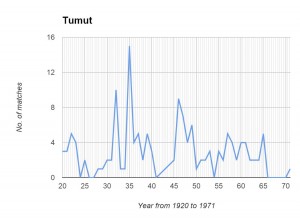 Tumut (141 matches). Many Cups were put into competition around the southwest, but after initial excitement most would be left forgotten in their cabinets. Tumut’s Cup may have been just an ‘Old Tin Pot’ but it cast a spell that led it to be lusted after for 52 years. Today it sits proudly, polished up with its ribbons in the National Rugby League Museum. Tumut won the first and, fittingly, the last Maher Cup matches. Rarely seeking imports Tumut couldn’t compete with key rivals Coota and Gundagai when they professionalised the game in the 1920s. However in 1935 they developed one of the classic Maher Cup teams, composed entirely of locals, coached by Joe Wilkinson and featuring an extraordinary 18 year old goal kicking fullback, Tom Kirk. In 1940 they closed down and went to the War, although some players moved over to Gundagai helping it wrest the Maher Cup for the first time in fourteen years. A team full of names common around Tumut – Clout, Crampton, Cruise, Hargreaves and Roddy enjoyed a great Cup run with an unrivalled defensive combination in 1946 and 47. In 1954 the weight of imports in Maher Cup football led Tumut to withdraw briefly, as they did again in the 1966 when they joined the MRL rebels. Fortunately they returned in ’71 to convincingly defeat Young at Alfred Oval to take their old cup back home to keep.
Tumut (141 matches). Many Cups were put into competition around the southwest, but after initial excitement most would be left forgotten in their cabinets. Tumut’s Cup may have been just an ‘Old Tin Pot’ but it cast a spell that led it to be lusted after for 52 years. Today it sits proudly, polished up with its ribbons in the National Rugby League Museum. Tumut won the first and, fittingly, the last Maher Cup matches. Rarely seeking imports Tumut couldn’t compete with key rivals Coota and Gundagai when they professionalised the game in the 1920s. However in 1935 they developed one of the classic Maher Cup teams, composed entirely of locals, coached by Joe Wilkinson and featuring an extraordinary 18 year old goal kicking fullback, Tom Kirk. In 1940 they closed down and went to the War, although some players moved over to Gundagai helping it wrest the Maher Cup for the first time in fourteen years. A team full of names common around Tumut – Clout, Crampton, Cruise, Hargreaves and Roddy enjoyed a great Cup run with an unrivalled defensive combination in 1946 and 47. In 1954 the weight of imports in Maher Cup football led Tumut to withdraw briefly, as they did again in the 1966 when they joined the MRL rebels. Fortunately they returned in ’71 to convincingly defeat Young at Alfred Oval to take their old cup back home to keep.
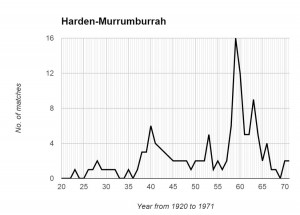 The ‘Hyphenates’ were before the War considered the easy-beats. However patiently building local talent, Harden-Murrumburrah (123 matches) exploded on the scene in 1940 with players such as Bill Kinnane, Billy Edwards and Wally Tozer. In the mid-fifties when top quality imports flooded into Group 9 Harden couldn’t compete – until they committed to following suit. In the rebuild, driven by Les ‘Dutchy’ Lee, they made exemplary buys in top kicker Bernie Nevin, Eric Kuhn the ‘Mighty Atom’ half-back from Barmedman, and Cowra’s ace rake Kevin ‘Roley’ Negus. Then they set about breaking all Maher Cup records with an incredible 29 consecutive victories – and usually won on the Sunday too. Harden remained an imposing team in both Cup and Group 9 competitions well into the 1960s.
The ‘Hyphenates’ were before the War considered the easy-beats. However patiently building local talent, Harden-Murrumburrah (123 matches) exploded on the scene in 1940 with players such as Bill Kinnane, Billy Edwards and Wally Tozer. In the mid-fifties when top quality imports flooded into Group 9 Harden couldn’t compete – until they committed to following suit. In the rebuild, driven by Les ‘Dutchy’ Lee, they made exemplary buys in top kicker Bernie Nevin, Eric Kuhn the ‘Mighty Atom’ half-back from Barmedman, and Cowra’s ace rake Kevin ‘Roley’ Negus. Then they set about breaking all Maher Cup records with an incredible 29 consecutive victories – and usually won on the Sunday too. Harden remained an imposing team in both Cup and Group 9 competitions well into the 1960s.
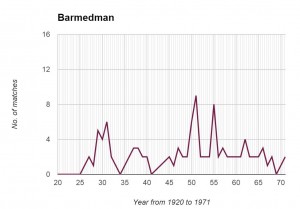 Barmedman (106 matches) was the only village that played more than a couple of Maher Cup matches. This success is partly explained by the munificence of business-owner John Lawrence, as well as having two of the most tenacious, articulate and skilled football administrators in Artie Kelly and later Bruce Maitland. Life in the little wheat town with three pubs seemed to revolve around Rugby League. The three spikes in the above graph correspond with the involvement of famous players George Mason, Tom Kirk and Keith Gittoes. Barmedman typically had an imported captain coach, leading a team composed overwhelmingly of locals, usually farmers. They came to be called the Clydesdales due to the hefty forwards who kept the ball in the pack – occasionally zipping out passes to whatever brilliant members of the Lawrence family were streaking up the line and kicking goals that year. Barmedman’s best runs came during the Depression and remarkably in the 1950s when many other towns packed their teams with top ranked imports. In the 1960s old timer Ron Crowe came down from West Wyalong to help the struggling village team by leading and coaching while stalwarts ‘Guts’ Quinlan and ‘Rusty’ Gorham were still giving all for the Maroons – 20 years after starting as lads. At Barmedman it was like family.
Barmedman (106 matches) was the only village that played more than a couple of Maher Cup matches. This success is partly explained by the munificence of business-owner John Lawrence, as well as having two of the most tenacious, articulate and skilled football administrators in Artie Kelly and later Bruce Maitland. Life in the little wheat town with three pubs seemed to revolve around Rugby League. The three spikes in the above graph correspond with the involvement of famous players George Mason, Tom Kirk and Keith Gittoes. Barmedman typically had an imported captain coach, leading a team composed overwhelmingly of locals, usually farmers. They came to be called the Clydesdales due to the hefty forwards who kept the ball in the pack – occasionally zipping out passes to whatever brilliant members of the Lawrence family were streaking up the line and kicking goals that year. Barmedman’s best runs came during the Depression and remarkably in the 1950s when many other towns packed their teams with top ranked imports. In the 1960s old timer Ron Crowe came down from West Wyalong to help the struggling village team by leading and coaching while stalwarts ‘Guts’ Quinlan and ‘Rusty’ Gorham were still giving all for the Maroons – 20 years after starting as lads. At Barmedman it was like family.
 Junee (79 matches) was the sort of industrial Labour-voting railway town where you would expect the Maher Cup to be a religion. Although continuing their commitment to the Cup for fifty years the Diesels didn’t set any records – except the biggest defeat in Maher Cup history, losing 72-3 at Barmedman in 1955. Crack Newtown five-eighth Keith Ellis came out in 1928 and quickly led a good team to victory. The team continued to be successful after his departure. The only other period of Cup prosperity was 1947-1950. Joe Jorgenson came to town fresh from captaining the Australian team. However the excitement soured when Joe went missing and was eventually found back in Sydney. They continued to perform well without Joe. With three brilliant local backs – bricklayer and coach Noel Bruce, Stan Larkings and Sid Delforce – Junee again achieved a Maher Cup run in 1950. The town was and is famous not only for developing Laurie Daley but also the incredibly successful annual Riverina Schoolboys’ Rugby League Carnival which has attracted thousands of young footballers for 60 years. Notwithstanding this, situated on the Australian Rules border and looking south towards Wagga, Junee was never as fanatically a Rugby League place as the other Maher Cup towns, except when playing Cootamundra.
Junee (79 matches) was the sort of industrial Labour-voting railway town where you would expect the Maher Cup to be a religion. Although continuing their commitment to the Cup for fifty years the Diesels didn’t set any records – except the biggest defeat in Maher Cup history, losing 72-3 at Barmedman in 1955. Crack Newtown five-eighth Keith Ellis came out in 1928 and quickly led a good team to victory. The team continued to be successful after his departure. The only other period of Cup prosperity was 1947-1950. Joe Jorgenson came to town fresh from captaining the Australian team. However the excitement soured when Joe went missing and was eventually found back in Sydney. They continued to perform well without Joe. With three brilliant local backs – bricklayer and coach Noel Bruce, Stan Larkings and Sid Delforce – Junee again achieved a Maher Cup run in 1950. The town was and is famous not only for developing Laurie Daley but also the incredibly successful annual Riverina Schoolboys’ Rugby League Carnival which has attracted thousands of young footballers for 60 years. Notwithstanding this, situated on the Australian Rules border and looking south towards Wagga, Junee was never as fanatically a Rugby League place as the other Maher Cup towns, except when playing Cootamundra.
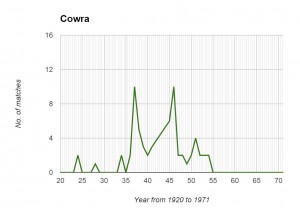 Cowra (63 matches) was when it bothered, a major Maher Cup town. However their link to the Southwest teams was fractious. Cowra had had enough of the Cup and protests and boom or bust football when the mania for imports reached it peak in 1954. They joined up with the Central West’s Group 10 instead and lived happily ever after. Cowra’s international Edgar Newham and boxer/coach Bill Maizey were key figures in the pre-War victories, and Dick McGuinness from Erambie after the War. In retrospect if the talent of Jim Murray and other brilliant Aboriginal athletes from the western edge of the town had been effectively embraced the record would likely have been much better. As it stands Cowra is best remembered for the match against Young in 1938 which was abandoned due to the referee refusing to adjudicate a donnybrook, and in 1951 against Gundagai where a crowd of 400 attacked referee Max Ibbotson, and ran him out of town.
Cowra (63 matches) was when it bothered, a major Maher Cup town. However their link to the Southwest teams was fractious. Cowra had had enough of the Cup and protests and boom or bust football when the mania for imports reached it peak in 1954. They joined up with the Central West’s Group 10 instead and lived happily ever after. Cowra’s international Edgar Newham and boxer/coach Bill Maizey were key figures in the pre-War victories, and Dick McGuinness from Erambie after the War. In retrospect if the talent of Jim Murray and other brilliant Aboriginal athletes from the western edge of the town had been effectively embraced the record would likely have been much better. As it stands Cowra is best remembered for the match against Young in 1938 which was abandoned due to the referee refusing to adjudicate a donnybrook, and in 1951 against Gundagai where a crowd of 400 attacked referee Max Ibbotson, and ran him out of town.
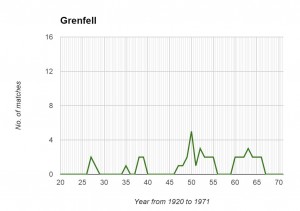 Grenfell (42 matches) was the size of Gundagai but never developed the same Rugby league passion and rarely a top class team. In 1938 and 39 the business folk got together and created a team stacked with imports from everywhere and settled down to prepare for the showdown with arch-rivals Young. It almost worked and the club went broke. Clem Kennedy came up from Souths and coached the team to four Maher Cup victories in 1950. Other than a shock defeat of Nevyl Hand’s Gundagai late in 1952, Grenfell never achieved much else. As time went on Group 9 were increasingly worried about the team’s survival. In the end they went down to ‘second division’ and Union became the top code in town.
Grenfell (42 matches) was the size of Gundagai but never developed the same Rugby league passion and rarely a top class team. In 1938 and 39 the business folk got together and created a team stacked with imports from everywhere and settled down to prepare for the showdown with arch-rivals Young. It almost worked and the club went broke. Clem Kennedy came up from Souths and coached the team to four Maher Cup victories in 1950. Other than a shock defeat of Nevyl Hand’s Gundagai late in 1952, Grenfell never achieved much else. As time went on Group 9 were increasingly worried about the team’s survival. In the end they went down to ‘second division’ and Union became the top code in town.
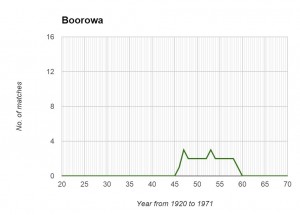 Although Boorowa (28 matches), was a keen Rugby League town it had only a brief flirtation with the Maher Cup. The second smallest Maher Cup place, its better players seemed to end up at nearby Young or Harden. The Blue Metal Boys‘ greatest moment was in defeating Herb Narvo’s Cootamundra in 1947 when Boorowa were lucky enough to secure the services of famed international George Watt. However once they had won the Cup Boorowa never once managed to defend it.
Although Boorowa (28 matches), was a keen Rugby League town it had only a brief flirtation with the Maher Cup. The second smallest Maher Cup place, its better players seemed to end up at nearby Young or Harden. The Blue Metal Boys‘ greatest moment was in defeating Herb Narvo’s Cootamundra in 1947 when Boorowa were lucky enough to secure the services of famed international George Watt. However once they had won the Cup Boorowa never once managed to defend it.
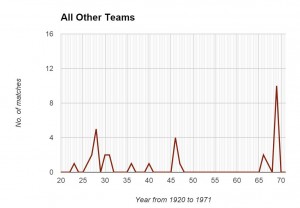 Other Places (33 matches). The twelve teams above account for 98% of Maher Cup appearances. A few villages made an appearance or two, with those in West Wyalong’s orbit providing fertile ground in the 1940s – Ungarie, Tullibigeal, Gibsonvale, and Mallee Plains. Wagga made an effort to be involved in the 1920s winning under Harry Caples and gaining some notoriety for a particularly puerile protest in 1930. But Wagga was always a predominately Australian Rules town and was never embraced by Group 9. After things were patched up following the Murrumbidgee Rugby League breakaway in the 1960s, the Wagga clubs participated – but without the heritage the Maher Cup played second fiddle to the local comp. The City of Crows’ main contribution was, as it grew, to place itself in the centre of Riverina Rugby League, and by doing so assisting in killing off the ailing Maher Cup and weakening the historic links forged between the towns of Group 9.
Other Places (33 matches). The twelve teams above account for 98% of Maher Cup appearances. A few villages made an appearance or two, with those in West Wyalong’s orbit providing fertile ground in the 1940s – Ungarie, Tullibigeal, Gibsonvale, and Mallee Plains. Wagga made an effort to be involved in the 1920s winning under Harry Caples and gaining some notoriety for a particularly puerile protest in 1930. But Wagga was always a predominately Australian Rules town and was never embraced by Group 9. After things were patched up following the Murrumbidgee Rugby League breakaway in the 1960s, the Wagga clubs participated – but without the heritage the Maher Cup played second fiddle to the local comp. The City of Crows’ main contribution was, as it grew, to place itself in the centre of Riverina Rugby League, and by doing so assisting in killing off the ailing Maher Cup and weakening the historic links forged between the towns of Group 9.
[Note on the graphs: no matches were played 1942-44, and for simplicity sake I’ve just drawn a line from 1941 to 1945]
